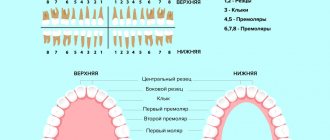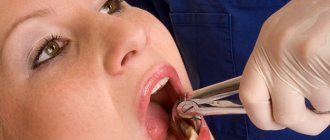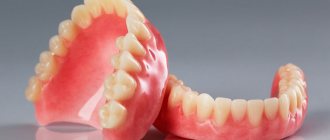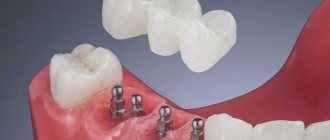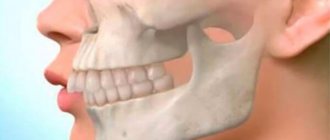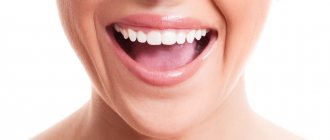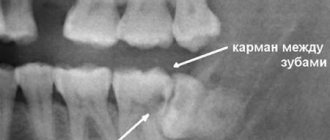The main difference between molars and premolars is their location in the dentition. Premolars are located closer to the smile zone, and molars are removed deeper.
The number of dental units also varies. Premolars are located two on each side on both jaws. There can be a pair of molars on each side, or maybe even three teeth. Third molars are wisdom teeth; they appear later than all other units. Wisdom teeth can grow in at twenty, thirty, or even later. There are cases when wisdom teeth are completely absent.
Difference between molars and premolars
The main difference between molar teeth and premolars is their location on the jaw.
Premolars are located closer to the front of the dentition, and molars are slightly moved inward. Their quantity also varies. There are always two premolars on each side of the upper and lower jaws. There can be either two or three molars. Still others are also called “wisdom teeth.” They grow later than others and often appear only at 20-25 years of age. This process is often accompanied by malaise and fever. However, not all people on earth have third ones. A certain genetic predisposition can cause the absence of wisdom teeth in the oral cavity.
Classifications of teeth
To begin with, it is worth clarifying the terminology, since many people understand the word molars to be permanent teeth. Although these are concepts from different classifications.
The following types of teeth are distinguished:
- incisors
ー these are the front teeth (“ones” and “twos”), they have a sharp edge and are used for biting off pieces of food; - fangs
ー conical teeth used for tearing dense food; - small molars
(premolars) - these are “fours” and “fives” in the dentition; - large molars
- sixes, sevens and eights. Large teeth with a wide chewing surface serve, like premolars, for grinding food.
That is, these teeth can also be milk teeth, but with their own characteristics - in children, in the milk bite, only the first and second molars are distinguished from the chewing ones. And it is with molars that problems arise - how to determine whether a child has milk or permanent teeth?
Features of the structure of molars
Molars have a characteristic structure. On the upper jaw they have three roots and four canals. The lower jaw has two roots and three canals. Moreover, the number of canals also differs depending on the location of the individual tooth. Thus, the first of them often have one more channel than the next two.
The main characteristic feature of this type of teeth is the area of their chewing surface. They bear the heaviest load when chewing food particles. The molars themselves also have differences among themselves, which are associated with the structure of the jaw.
Central lower incisor
Average age of eruption: 6-7 years
Average age of root formation: 9 years
Average length: 20.7 mm
Narrow and flat in the labial-lingual direction, the lower central incisor is the smallest adult tooth. Radiologically it is visible in only one projection and thus appears more accessible than it actually is. The crown, narrow in lingual projection, has a limited area for access. For gentle access formation, a fissure bur and a spherical bur No. 2 are used. The access cavity should be oval and performed on the lingual side.
The lower central incisor often has two canals. One study reported that 41.4% of mandibular central incisors studied had two separate canals, of which only 1.3% had two separate apical foramina [1]. After completing the access formation, the doctor must examine the tooth cavity to identify an additional canal. Endodontic treatment failures in the lower incisor area are most often associated with an unidentified canal, usually in the lingual location. To create conditions for the straight entry of endodontic instruments into the additional canal, access can be expanded in the incisal direction.
There is a great danger of perforation of the vestibular wall, but it can be avoided if the doctor remembers that it is almost impossible to perforate in the lingual direction, since the bur axis is in contact with the incisal edge. The slit-like lumen of the canal is so common that it can be considered a normal variant, and this requires special attention when cleaning and shaping.
Lateral perforations and pulp anatomy will be discussed in an illustration of the lower second molar.
Molar Differences
Often the surface of each molar tooth is shaped like a triangle. There is a certain number of tubercles on it, which take an active part in chewing food. The number of such tubercles may vary. Usually there are three, but sometimes there are more.
Such mounds are connected to each other by special ridges. On the upper and lower jaws the structure of these elements is different. In the upper dentition, the apex of the surface triangle is directed towards the tongue. This form is called a trigon. On the lower jaw, the apex of such a triangle is directed towards the cheek, which is called the trigonid. The size of the first and second types of teeth is practically the same.
Eighth teeth are more likely than others to suffer from caries and other diseases.
This is due to their remote location and the inability to thoroughly clean them. Which leads to a large accumulation of bacteria and the development of caries, gingivitis, and periodontitis. Treatment in such situations is possible, but filling is often complicated by twisted roots and canals. Also, many people cannot open their mouths wide enough or some have a pronounced gag reflex - this significantly complicates the dentist’s work. Due to objective reasons, the “eights” are treated poorly.
Therefore, if the patient wants to keep the unit, a consultation with a dentist is required, who can professionally assess the situation and make the right decision.
Possible damage to small molars
Carious lesions of primary and molar teeth in children are observed quite often. This is due to the bumpiness of their surface, which can trap food particles and bacteria. Since children at an early age do not always actively and correctly brush their teeth, these residues can lead to damage to the enamel and deeper spread of caries.
Depending on the degree of damage, caries can penetrate either exclusively into the enamel, or into dentin or even cement. In the latter case, we are talking about deep caries, which often requires serious treatment or even tooth extraction.
Another variant of damage is a change in tissue structure, which may be associated with metabolic disorders in the human body or other diseases. Such a disease can also be the result of poor nutrition or constant diets, in which the body does not receive enough nutrients.
At any age, a person can experience excessive tooth wear, which leads to the destruction of enamel and can cause other serious damage. Teeth can wear down in different situations, such as:
- if a person has bad habits of grinding his teeth, etc.;
- in case of improper or insufficient nutrition;
- in the presence of diseases of the endocrine system;
- due to a genetic predisposition to enamel depletion.
All of these lesions can be the result of both an incorrect lifestyle and various diseases or heredity. Regardless of the reasons, it is necessary to begin treatment of emerging injuries immediately so as not to aggravate the process.
The eruption of “figure eights” is almost always associated with complications
Difficulties in eruption of third molars are caused not only by lack of space, but also by the fact that they do not have deciduous predecessors. Therefore, they often grow only partially or at an angle. But even the appearance of units growing correctly in most cases causes complications.
Most often found:
- destruction or displacement of adjacent teeth;
- bite problems;
- pericoronitis.
Very often, the eruption of the figure eight is accompanied by a purulent-inflammatory process. This happens because a hood appears over the tooth, and around it there is a pocket in which bacteria, plaque and food debris accumulate. They create favorable conditions for the development of inflammation (pericoronitis).
Often, when the eighth tooth appears, severe pain is felt, which occurs due to oppression of the roots of neighboring units.
Replacement of primary molars with permanent permanent molars
Molars are the first permanent teeth to appear in a child's mouth. This begins around the age of five. Growth begins with the first molar tooth, which appears in a free space in the depths of the jaw, closer to the milk one that has not yet fallen out.
The second molar usually grows in at the age of 12-13 years. It also takes up free space and does not replace a baby tooth. The latter, or “wisdom teeth,” may take up to 25 years to grow or may not appear at all.
As for dairy products, they begin to fall out from the age of 9. In their place, permanent teeth grow, which occurs at approximately 10-12 years of age. Usually these are the last molars, the growth of which must wait to fill the adult dentition (not counting “wisdom teeth”).
Is it possible to loosen baby molars?
The process of tooth loss always begins with softening of its root. This occurs as the jaw grows, freeing up more space for a permanent tooth. Thus, while the baby tooth is still in the hole, the molar is already beginning to take its correct place.
In this regard, dentists categorically do not recommend deliberately loosening baby molars. If they fall out prematurely, jaw growth may be stunted. As a result, there will not be enough space for permanent teeth, and they will begin to grow crookedly, getting out of the general dentition.
Signs of imminent appearance of molars
The first signs that molars are about to appear are noticeable even before the baby teeth fall out. These include the following:
- widening of the jaw, which can be seen when gaps appear between other baby teeth;
- the appearance of sufficient free space behind the outer lateral milk teeth;
- swelling of the gums.
In this case, the temperature does not necessarily have to rise or the child’s well-being deteriorates, as was the case with the growth of baby teeth. This is why the appearance of the first molars often goes unnoticed.
Helping your child replace teeth
The process of replacing teeth often takes place without pain or discomfort. The roots of baby teeth dissolve on their own, and the dental crown falls out freely. However, there are a number of recommendations that should be followed during this period.
The main one is systematic rinsing of teeth for disinfection purposes. This is necessary in order to avoid bacteria from entering the hole that will form at the site of the falling tooth. In addition, the sharp edges of a crown that has separated from the gum may cause minor damage to soft tissue. To prevent them from becoming inflamed, it is important to exclude any infection.
If your child experiences any pain during the tooth replacement stage, you should immediately consult a doctor. Under no circumstances should pain be eliminated using improvised methods.
Molars and prevention of their loss
Molars are stronger than baby teeth. However, they need proper care to prevent their loss, because new ones will not grow in place of a lost tooth.
Prevention of molar tooth loss involves proper oral hygiene. It includes systematic brushing of teeth, use of dental floss and mouthwash. In addition, you should carefully monitor the condition of your teeth and consult a doctor if even minor damage is detected.
Proper balanced nutrition is also mandatory. Especially in childhood and adolescence, you need to ensure that your body gets enough calcium and vitamin D.
Wisdom teeth need to be removed early
There is still debate in the dental community about the need to remove third molars in advance, even if they do not bother you. However, most experts are still inclined to believe that this is not worth doing. Scientists do not have sufficient evidence that preventive removal can preserve oral health in the future.
Indications for tooth extraction are:
- its incorrect location;
- lack of space for teething;
- destruction of the adjacent seventh molar;
- deep caries (pulpitis, periodontitis);
- crowding of units;
- inflammation of the hood.
In these cases, there is no point in fighting for the G8. And, if it is not possible to save the molar, you should think about choosing a dentistry where experienced professionals will remove the tooth.
Maxillary premolars
The crown of the premolars on the upper dentition has a prismatic shape. The buccal and palatal bones often have a convex surface. The first and second premolars in the row also have their differences.
First premolar
The difference between the first premolar of the upper jaw is the predominance of the vestibular surface over the palatal surface. Its contact surfaces are rectangular in shape. The buccal tubercle has two distinct slopes. The root of such a tooth often has a bifurcation.
Second premolar
In such a tooth, the buccal surface usually predominates over the palatal surface, which is more rounded. In most cases, this premolar tooth has a single cone-shaped root. However, there are also cases when it has a split.
Number of roots in human teeth
There can only be one dental crown, but the number of roots a tooth has depends on its location and purpose. The number of roots is also influenced by hereditary factors. It is possible to determine how many roots a tooth has only with the help of an x-ray. The inner part of the tooth (root) makes up about 70% of the entire tooth.
Factors influencing the number of roots:
- Location of the tooth.
- The purpose of the tooth, its functionality (chewing or frontal).
- Genetic predisposition.
- Patient's age and race. In the European race, the number of dental roots is very different from the Negroid and Mongoloid races.
Treatment methods for chewing teeth in adults and children
The whole difficulty lies in the difficult passage of the channels of the masticatory elements. When processing them, there is a serious risk of injury to the pulp, which can provoke pulpitis. In this case, two treatment options can be distinguished:
- depulpation – partial or complete removal of the pulp with further endodontic treatment, that is, cleaning and filling the canals. This method is more often used in adult dentistry,
Surgical method of pulp treatment - biological method - a medicine, usually an antibiotic, is applied to the affected area of the pulp, after which a temporary filling is placed on top. The active substances of the drug destroy pathogenic microorganisms and stop the inflammatory process. It must be admitted that pulpitis on baby teeth progresses much faster than on adults, so quite often the doctor has no choice and removes the affected temporary element. If necessary, prosthetics can be performed before a permanent one appears.
This method involves killing the pulp with medication.
Molars are directly involved in the process of chewing food. Like other teeth, they require timely diagnosis and treatment. And in case of their early loss, it is imperative to take care of their correct replacement - the best option for this would be implantation.
Regular cleaning is the basis of hygiene. But even if we follow this rule responsibly, we cannot completely clean out all food debris and bacteria in one such procedure. Subsequently, they transform into plaque and hard stone, which causes gums to become inflamed, teeth to decay and rot. Therefore, it is so important to regularly visit the dentist for a preventive examination and professional cleaning of plaque and deposits. It is also important not to forget to rinse your mouth after each meal, use floss and, preferably, an irrigator. Proper care of your oral health will be the best prevention of any dental diseases.
1Dmitrienko, CB Anatomy of human teeth, 2000.
Causes for concern
However, in some cases, irregular teething requires medical intervention. Firstly, children have so-called natal and neonatal teeth: if your child was born with teeth or they erupt in the first month of life, you should immediately consult a dentist. As experts explain, these teeth can be additional, or supernumerary, or complete, but erupted very early. They are distinguished by great mobility. If the dentist determines that the teeth are supernumerary, he or she may recommend removing them.
Also, a visit to the dentist may be necessary in case of congenital absence of teeth, or hypodontia. According to researchers from the Kazan State Medical Academy, the absence of incisors or first molars of the upper jaw is extremely rare; Heredity plays a significant role in the development of this deviation.
As soon as your baby's first teeth emerge, start using a special baby toothbrush with a small head and very soft bristles designed to gently but effectively clean baby teeth. Teach your child good oral care from an early age, and be sure to schedule a visit to the dentist between the eruption of the first tooth and your baby's first birthday.
Symptoms
Usually, no serious problems arise during teething, but local (in rare cases systemic) disturbances are present. These include:
- swelling and soreness of the gums;
- profuse drooling;
- irritability;
- restless sleep;
- lethargy;
- the baby's need for biting and chewing;
- poor appetite.
Loose stools, low-grade fever and runny nose are less common than the above symptoms.
Important! If the body temperature rises above 38 degrees, convulsions, difficulty breathing, you need to show the baby to a doctor and call an ambulance. This may indicate a viral infectious disease and is not a sign of teething.
Some parents wonder why this process occurs differently in babies. For example, in some teething occurs with fever, in others it does not. It is noted that, among other factors, this is also influenced by the child’s constitutional type. In children of the allergic type, this period may be accompanied by increased moodiness, atopic dermatitis, and ARVI is often associated. Infants with asthenic syndrome sleep poorly, refuse to eat, and cry for a long time due to severe pain.
